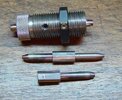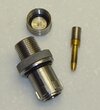Whether .308 or any other rifle cartridge, each rifle chamber can, and usually is a bit different, so a case fired in one rifle may or may not chamber in another rifle of the same caliber.
Somehow have ended up with a set of RCBS Neck Size Bushing Dies and a regular set (not bushing) of FL RCBS dies.
There are several ways to approach the multiple rifles of same caliber and you have the tools to handle it properly.
First off, neck sizing only is often used by reloaders seeking best accuracy, but can cause issues if a case fired in the larger chamber is reloaded using neck sizer only and then inserted in the tighter chamber, thus, the easy solution in your case would be to set your regular full length sizer to fit the smaller chamber and forget the neck sizer die. Thus all your reloads will chamber easily in either rifle. This is common practice, especially in hunting rifles for which you are not trying for one hole groups.
One thing to remember about using neck sizer only, even if cases being reloaded were fired in the rifle for which you are loading is that after a few firings (usually 2nd or 3rd), the case will not chamber freely (again, even in the rifle in which it has been fired) and it must be full length resized.
Since both your rifles are bolt guns you should detect a slight resistance in chambering the round before it becomes a serious problem. In gas guns, this tight chambering can be a danger which could cause a slam-fire or
worse yet an out of battery slam-fire.
I load for several gas guns and make it a practice to full length size every time, even if cases are used in one rifle only. Just set my sizer to push shoulder back about .003" from the fired dimension of fired cases. Since my .308 loading is for two different rifles, one bolt gun and the other a gas gun, and I'm always seeking best accuracy for both, I have two different full length sizer dies, one set up specifically for each rifle.
ETA: What Blue & rsrocket said.......I'm slow @ typing.





